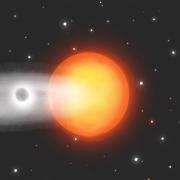Scientists have announced that NASA’s James Webb Space Telescope has allowed them to capture definitive evidence for carbon dioxide in the atmosphere of a planet about 700 light-years away from Earth.
The finding, accepted for publication in Nature, is the first indisputable evidence for carbon dioxide in the atmosphere of a planet orbiting a distant star.
The results are indicative of the telescope’s ability to spot key molecules like carbon dioxide in a wide variety of exoplanets—including smaller, cooler, rocky planets—providing insights into the composition, formation, and evolution of planets across the galaxy.
“When we first looked at this data, all I could say was, ‘Holy cow,’” said Jacob Bean, a UChicago astronomer who co-leads the team working to analyze exoplanet results from the new telescope. “The whole group was just blown away. The telescope is working even better than we hoped it would.
“And this discovery is from just a small portion of the observing time,” he said. “This is like the first chapter in an entirely new book we’ll be writing about exoplanets in the coming months.”
The detection helps scientists fill out their picture of the exoplanet’s atmosphere as it exists today, but also serves as a way to understand how this and other planets formed in the first place.
Filtered starlight
The planet, called WASP-39b, is a hot gas giant planet orbiting a star similar to our own sun. WASP-39b’s mass is about the same as Saturn, but its diameter is 1.3 times greater than Jupiter. Its extreme puffiness is related in part to its high temperature (about 1600°F); WASP-39 b orbits very close to its star, completing one circuit in just over four Earth days.
The planet was initially discovered in 2011, when a ground-based telescope detected the subtle, periodic dimming of light as the planet moves across the face of the star.
But the James Webb Space Telescope, known as JWST, is so sensitive that it can readily detect not just the dimming of overall light from the planet crossing in front of the star, but the tiny amount of starlight that passes through the planet’s atmosphere.
Different gases absorb different combinations of colors, so researchers can analyze small differences in brightness of the transmitted light across a spectrum of wavelengths to determine exactly what an atmosphere is made of.
Though there are hints from previous observations, no one has ever been able to put together a complete account of all the different gases and molecules in an exoplanet’s atmosphere. The researchers hope that JWST will allow them to do this for WASP-39 b, as well as many other exoplanets.
A window into formation
The composition of a planet’s atmosphere tells us something about the origin of the planet and how it evolved.
For example, gas giant planets are thought to form when a clump of ice and rocks becomes big enough that its gravity starts pulling in gases around it.
Carbon dioxide in particular can give scientists a window into the details of this process. Its presence means that there were a lot of “heavier” molecules like carbon and oxygen floating around during the formation, likely because the planet was pulling in a lot of dust and rock along with the hydrogen and helium gas as it formed.
The size of the carbon dioxide feature observed on WASP-39 b suggests that it has a similar composition to Saturn and must have formed much farther away from its star than it is today.
The results are also exciting to scientists for what they mean for the future of exoplanet observations.
“Detecting such a clear signal of carbon dioxide on WASP-39 b bodes well for the detection of atmospheres on smaller, terrestrial-sized planets,” said Natalie Batalha of the University of California at Santa Cruz, who leads the team.
This observation of WASP-39 b is just one part of a larger investigation that includes observations of the planet using multiple JWST instruments, as well as observations of two other transiting planets.
The investigation, which is part of the Early Release Science program, was designed to provide the exoplanet research community with robust JWST data as soon as possible.
Bean was one of the founders of this group, which was intended to quickly understand how JWST’s instruments would work for the particular goal of studying exoplanets. For example, studying an exoplanet requires the telescope to hold perfectly still for multiple hours to catch the planet crossing in front of its star—which is different than the method to capture snapshots of faint faraway galaxies.
“So far we’re really happy. The instruments are rock solid, and the signal is just beautifully clear,” said Bean.
“The goal is to analyze the Early Release Science observations quickly and develop open-source tools for the science community to use,” explained Vivien Parmentier, a co-investigator from Oxford University. “This enables contributions from all over the world and ensures that the best possible science will come out of the coming decades of observations.”
Citation: "Identification of carbon dioxide in an exoplanet atmosphere." The JWST Transiting Exoplanet Community Early Release Science Team, Nature, Aug. 2022.
Funding: NASA.
Adapted in part from a NASA release.

